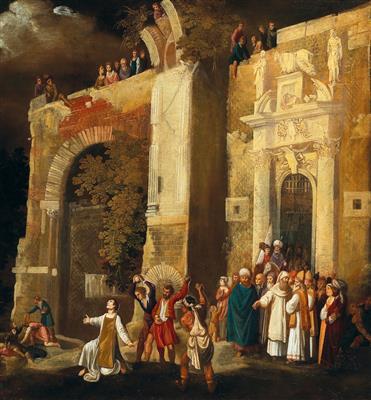Francois de Nomé, called Monsu Desiderio

(Metz circa 1593 – after 1644 Naples)
The Martyrdom of Saint Stephanus,
oil on canvas, 93.1 x 87.4 cm, framed
Provenance:
sale, Sotheby’s, New York, 14 October 1992, lot 133 (as François de Nomé)
Private collection, USA
We are grateful to Maria Rosaria Nappi and Nicola Spinosa for independently confirming the attribution. Spinosa has suggested that the figures may be by Aniello Falcone.
Until the mid-twentieth century, François de Nomé had been associated with Monsù Desiderio, a name traditionally used to cover the work of two different artists: François de Nomé and Didier Barra. Both artists were natives of Metz, but worked in Naples, and it was there, in the Spanish-ruled city, that they created their fantastic visions. The chronology of the artist’s oeuvre is difficult to establish as only a few of his paintings are dated.
However, he produced a small group of paintings of scenes featuring martyrdoms very early in his career (see The Martyrdom of Saint Agatha, sold at Christie’s, Rome, on 26 January 1978, lot 18). This group shares with the present work a similar scale of figures – larger than most of his later works – and similar types and groupings of on-lookers. It therefore seems likely that the present lot dates from the same period in the artist’s oeuvre.
François de Nomé moved to Rome around the age of eleven. He trained there with Master Baldassare, who was probably the Flemish landscape painter Balthazar Lauwers. In addition to the influence of this artist’s work and that of Paul Bril, François de Nomé’s paintings look to the elaborate architectural compositions of Hans Vredeman de Vries and to theatrical scenes by Jacques Callot and Giulio Parigi. From 1610 onwards De Nomé is documented in Naples, where he remained for the rest of his life. By the end of the second decade of the century his works had acquired a certain reputation, and in 1618 he received his first important commission for a cycle of twelve paintings with episodes from the life of the Pharaoh (location unknown). François de Nomé’s work is characterised by the application of heavy impasto. The paintings attributed to him show a preference for two themes: firstly, perspectival views of streets and churches, and secondly, highly ornate ruins and fantastical buildings that act as the backdrop for biblical narratives painted on a small scale.
Expert: Dr. Alexander Strasoldo
 Dr. Alexander Strasoldo
Dr. Alexander Strasoldo
+43 1 515 60 403
oldmasters@dorotheum.com
17.10.2017 - 18:00
- Dosažená cena: **
-
EUR 24.917,-
- Odhadní cena:
-
EUR 20.000,- do EUR 30.000,-
Francois de Nomé, called Monsu Desiderio
(Metz circa 1593 – after 1644 Naples)
The Martyrdom of Saint Stephanus,
oil on canvas, 93.1 x 87.4 cm, framed
Provenance:
sale, Sotheby’s, New York, 14 October 1992, lot 133 (as François de Nomé)
Private collection, USA
We are grateful to Maria Rosaria Nappi and Nicola Spinosa for independently confirming the attribution. Spinosa has suggested that the figures may be by Aniello Falcone.
Until the mid-twentieth century, François de Nomé had been associated with Monsù Desiderio, a name traditionally used to cover the work of two different artists: François de Nomé and Didier Barra. Both artists were natives of Metz, but worked in Naples, and it was there, in the Spanish-ruled city, that they created their fantastic visions. The chronology of the artist’s oeuvre is difficult to establish as only a few of his paintings are dated.
However, he produced a small group of paintings of scenes featuring martyrdoms very early in his career (see The Martyrdom of Saint Agatha, sold at Christie’s, Rome, on 26 January 1978, lot 18). This group shares with the present work a similar scale of figures – larger than most of his later works – and similar types and groupings of on-lookers. It therefore seems likely that the present lot dates from the same period in the artist’s oeuvre.
François de Nomé moved to Rome around the age of eleven. He trained there with Master Baldassare, who was probably the Flemish landscape painter Balthazar Lauwers. In addition to the influence of this artist’s work and that of Paul Bril, François de Nomé’s paintings look to the elaborate architectural compositions of Hans Vredeman de Vries and to theatrical scenes by Jacques Callot and Giulio Parigi. From 1610 onwards De Nomé is documented in Naples, where he remained for the rest of his life. By the end of the second decade of the century his works had acquired a certain reputation, and in 1618 he received his first important commission for a cycle of twelve paintings with episodes from the life of the Pharaoh (location unknown). François de Nomé’s work is characterised by the application of heavy impasto. The paintings attributed to him show a preference for two themes: firstly, perspectival views of streets and churches, and secondly, highly ornate ruins and fantastical buildings that act as the backdrop for biblical narratives painted on a small scale.
Expert: Dr. Alexander Strasoldo
 Dr. Alexander Strasoldo
Dr. Alexander Strasoldo
+43 1 515 60 403
oldmasters@dorotheum.com
|
Horká linka kupujících
Po-Pá: 10.00 - 17.00
old.masters@dorotheum.at +43 1 515 60 403 |
| Aukce: | Obrazy starých mistrů |
| Typ aukce: | Salónní aukce |
| Datum: | 17.10.2017 - 18:00 |
| Místo konání aukce: | Wien | Palais Dorotheum |
| Prohlídka: | 07.10. - 17.10.2017 |
** Kupní cena vč. poplatku kupujícího a DPH(Země dodání Rakousko)
Není již možné podávat příkazy ke koupi přes internet. Aukce se právě připravuje resp. byla již uskutečněna.
Všechny objekty umělce
